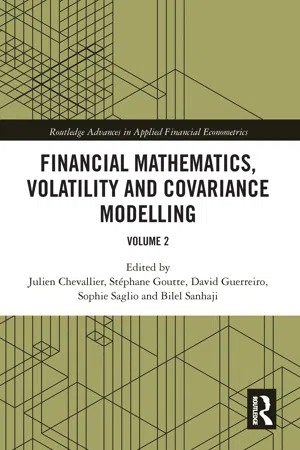Steven J. Cochran, Iqbal Mansur, and Babatunde Odusami
1. Introduction
There is considerable evidence that commodity and, in particular, metal return, volatility exhibits long-term temporal dependence (see, e.g., Crato and Ray (2000), Jin and Frechette (2004), Baillie et al. (2007), Figuerola-Ferretti and Gilbert (2008), and Cochran et al. (2012)). However, these studies, as well as others, assume that the volatility generating process follows a single regime. The single regime assumption is an important limitation since a significant amount of research has shown that financial time series often exhibit strong non-linearities and that the single regime Generalized Autoregressive Conditional Heteroskedastic (GARCH) family of models are unable to capture the full extent of the non-linear behavior (see, e.g., Hsieh (1991)). For example, if structural breaks exist, financial time series may appear to be piecewise linear but are, in fact, jointly non-linear. Lamoureux and Lastrapes (1990) have shown that structural breaks in the variance, which may result from factors such as changes in Federal Reserve monetary policy, economic outlook, and inflationary expectations, may produce spuriously high persistence in volatility in a GARCH model. If the variance is high and remains so for a period and then low and remains so for a period, persistence of such piecewise homoskedastic periods results in volatility persistence. A GARCH model that cannot adequately capture the persistence of such periods may not only produce volatility persistence that is spurious but parameter estimates that are unstable.
The objective of this study is to address the issues of period-wise linearity and overall non-linearity by introducing a threshold effect in commodity returns and in their conditional volatilities for four major commodity groups, namely, industrial metals, precious metals, and agricultural and energy commodities. A double threshold fractionally integrated GARCH, (DT)-FIGARCH(1,δ,1), model is developed in order to examine the threshold effect and, based on the findings of Jin and Frechette (2004), Baillie et al. (2007), and Cochran et al. (2012), will be employed to incorporate the long-memory process of commodity return volatility. Using the term spread as a proxy for inflationary expectations, the endogenously determined threshold employed in this study permits the determination of whether commodity returns and both short-term and long-term volatility persistence exhibit asymmetric patterns, which are ordinarily assumed away under a single regime specification.
The four commodity groups studied here are vital to global economic activity and include industrial metals (aluminum, copper, tin, and zinc), precious metals (gold, silver, and platinum), agricultural commodities (corn and soybeans), and energy commodities (oil, heating oil, and natural gas). This broad sample of commodities permits an investigation as to whether commodities constitute a homogenous asset class with regard to their relationships with the stock market and whether these relationships are regime dependent. Given the economic importance of these commodities, investors, traders, portfolio managers, and central bank and other government officials should be interested in understanding their return and volatility dynamics and how these dynamics are affected by threshold regime changes. Although the price of each commodity is affected by the fundamental demand-supply dynamics and speculative forces in its own market,1 commodity prices are, in general, highly correlated. For example, the correlation coefficients between oil prices and the prices of the agricultural commodities, precious metals, and industrial metals used in this study are in the range of 0.80.2 For the energy commodities, the correlation coefficient between oil and heating oil is also approximately 0.80 but that between oil and natural gas prices is the weakest (0.24) among all commodities. Natural gas prices are also negatively correlated with gold, silver, tin, soybean, and corn prices. Although a substitute for oil in various circumstances, the demand-supply forces in the natural gas market appear to differ substantially from those in the other energy markets (oil and heating oil). The relationship between oil and natural gas prices is indirect and is based on the competition between natural gas and residual fuel oil (see Hartley et al. (2008)). Although a long-term relationship exists between crude oil and natural gas prices, the short-run dynamics can result in considerable variation in the relative prices of these two energy commodities (see Brown and Yücel (2008)). Additionally, factors such as inventories and weather, as well as other seasonal events and factors, have significantly more impact on the short-run dynamics of natural gas prices than on those of other non-agricultural prices.
During mid-2008, led by crude oil, commodity prices reached virtually unbelievable highs and then subsequently declined very quickly. Persistent decreases in commodity prices continued over the 2010–2015 period. Since 2010, commodity prices have fallen by 40% while growth in emerging and developing economies has slowed from 7.1% in 2010 to 3.3% in 2015 (Commodity Market Outlook (January 2016)). Although the issue is largely unsettled, financialization in the form of speculative buying by index funds in the commodity futures and over-the-counter (OTC) derivatives markets is often considered to be a contributing factor in the creation of speculative bubbles that result in commodity prices, and crude oil prices in particular, to far exceed their fundamental values at their peaks (see Gheit (2008)). Additionally, recent studies have argued that global investors consider commodities as alternative investment instruments and, therefore, are subject to speculative behavior. As oil and precious metals are priced in US dollars, these commodities can be used as hedges by investors and speculators. In terms of portfolio diversification, Hammoudeh et al. (2009) recommend the inclusion of gold and silver in a portfolio that already holds oil and copper. Similarly, Sari et al. (2010) find tha...
